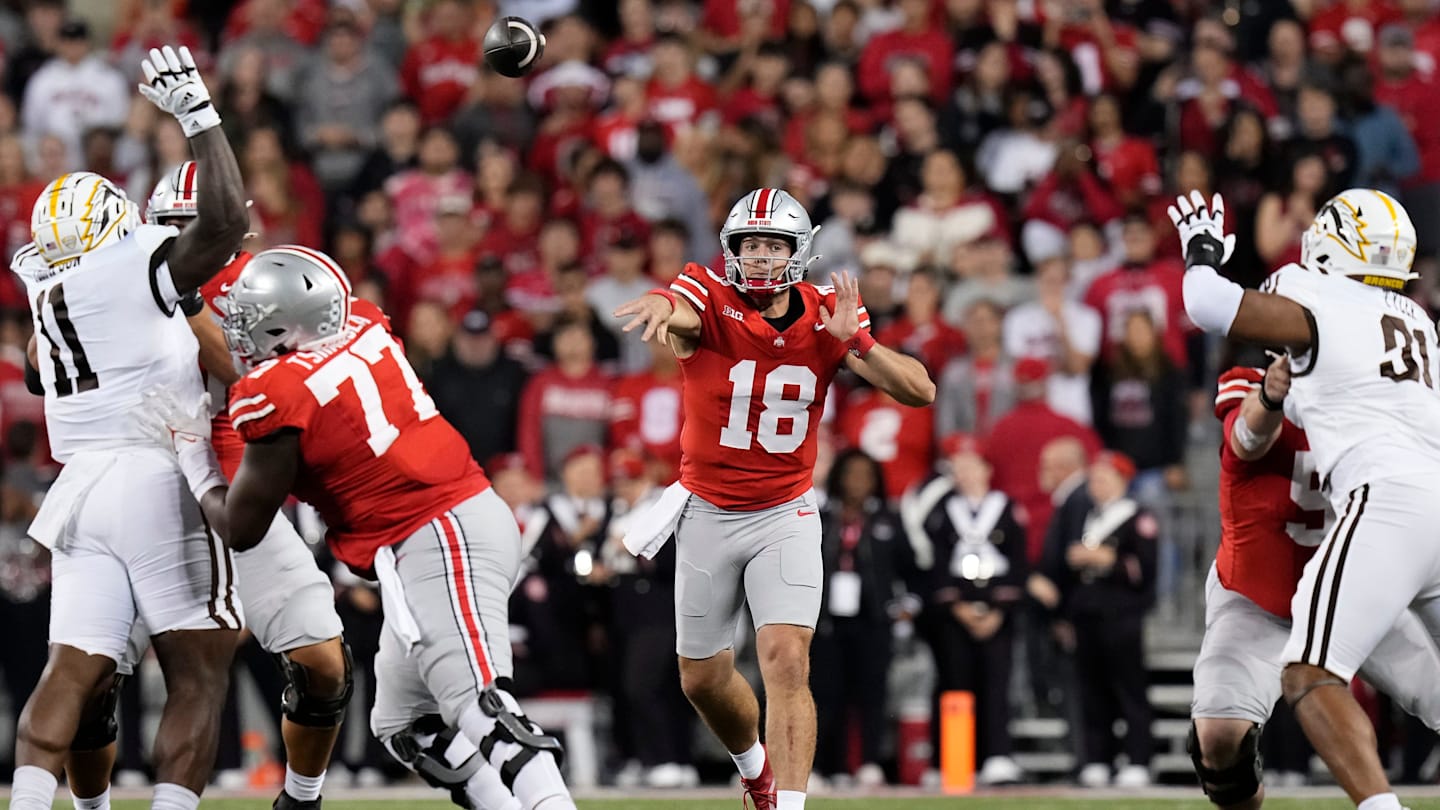Lifestyle
Can anything slow fast fashion down? Lawmakers are giving it a go
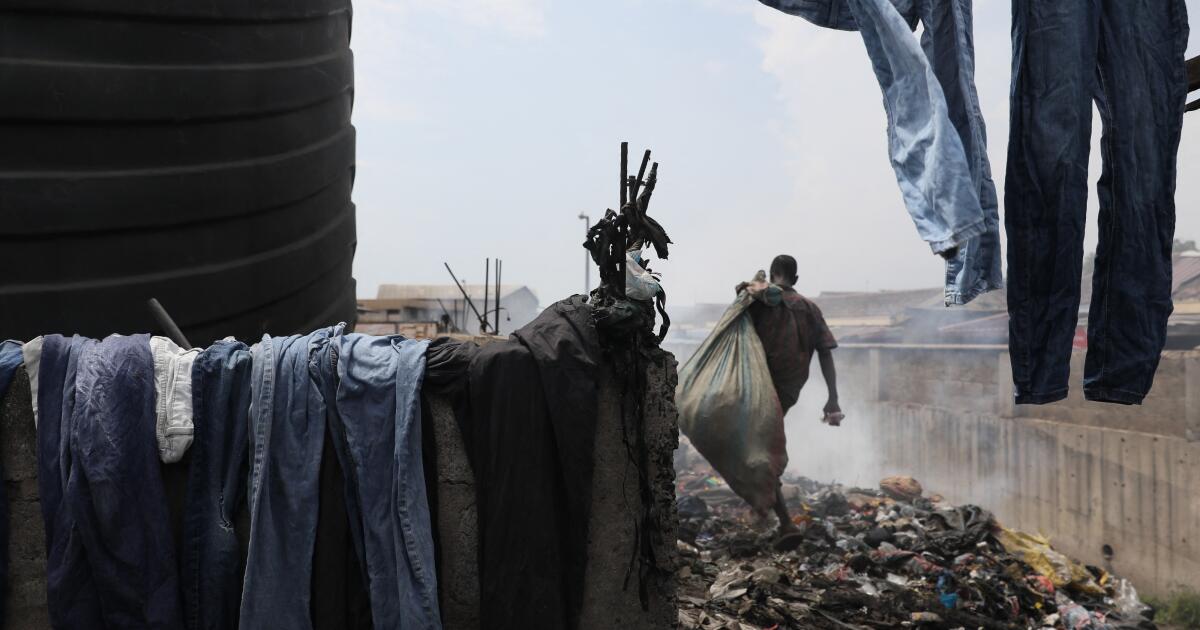
Worldwide criticism of fast fashion’s waste, labor abuses and carbon emissions has done little to slow down the industry. But new legislation could alter the flood of goods — like the floral print jumpers priced at, say, $2.99, the kids’ T-shirts selling for $4.26 or the tank tops for $4.88.
The term “fast fashion” — which emerged in the 1990s alongside Zara, a European company selling runway-inspired styles at affordable prices — has come to define trendy, low-cost clothing to wear and throw away.
The business model has been popular among shoppers and brands, which keep their inventories low, try to predict what customers want and use highly-flexible supply chains for quick turnaround. The latest iterations are epitomized by the wildly successful Chinese e-commerce platforms Shein and Temu.
A traditional retailer may offer 1,000 different styles per year, said Sheng Lu, professor and graduate director of fashion and apparel studies at the University of Delaware. Compare that to the first generation of fast-fashion brands, Zara and H&M, which put out about 20,000 per year. Shein, he added, which has garnered the label of “ultra-fast fashion,” churns out 1.5 million different styles per year.

Clothing production doubled between 2000 and 2014, a consulting firm estimates, and the number of garments purchased per capita rose 60%.
(Thibault Camus / Associated Press)
According to consulting firm McKinsey & Co., which estimates the global fashion industry to be worth $1.7 trillion, clothing production doubled between 2000 and 2014, and the number of garments purchased per capita increased by 60%. At the current pace, McKinsey predicts clothing and footwear consumption will increase from 62 million tons in 2019 to 102 million tons in 2030, “equivalent to more than 500 billion additional T-shirts,” according to the Clean Clothes Campaign.
As clothing prices have plummeted — a few months ago, McKinsey reported that the average price of a product on Shein is $14, $26 at H&M and $34 at Zara — customers have fewer qualms about tossing them. Less than 1% of fashion textiles are recycled, McKinsey reported, and 3 out of every 5 garments end up in a landfill or are incinerated per year.
But as fast fashion’s popularity rises, so has the backlash against it, drawing the ire of environmental groups, labor activists and lawmakers across Europe and the United States. “The discussion on fast fashion is quickly moving from the traditional business aspect to the policy aspect,” Lu said.
Recent legislation in several countries is aimed at curbing the environmental impact of the fashion industry, whose planet-warming greenhouse gas emissions are estimated to exceed those of international flights and maritime shipping combined. McKinsey estimates that the fashion industry accounts for between 3% and 8% of the world’s greenhouse gas emissions, and could increase by another 30% by 2030.
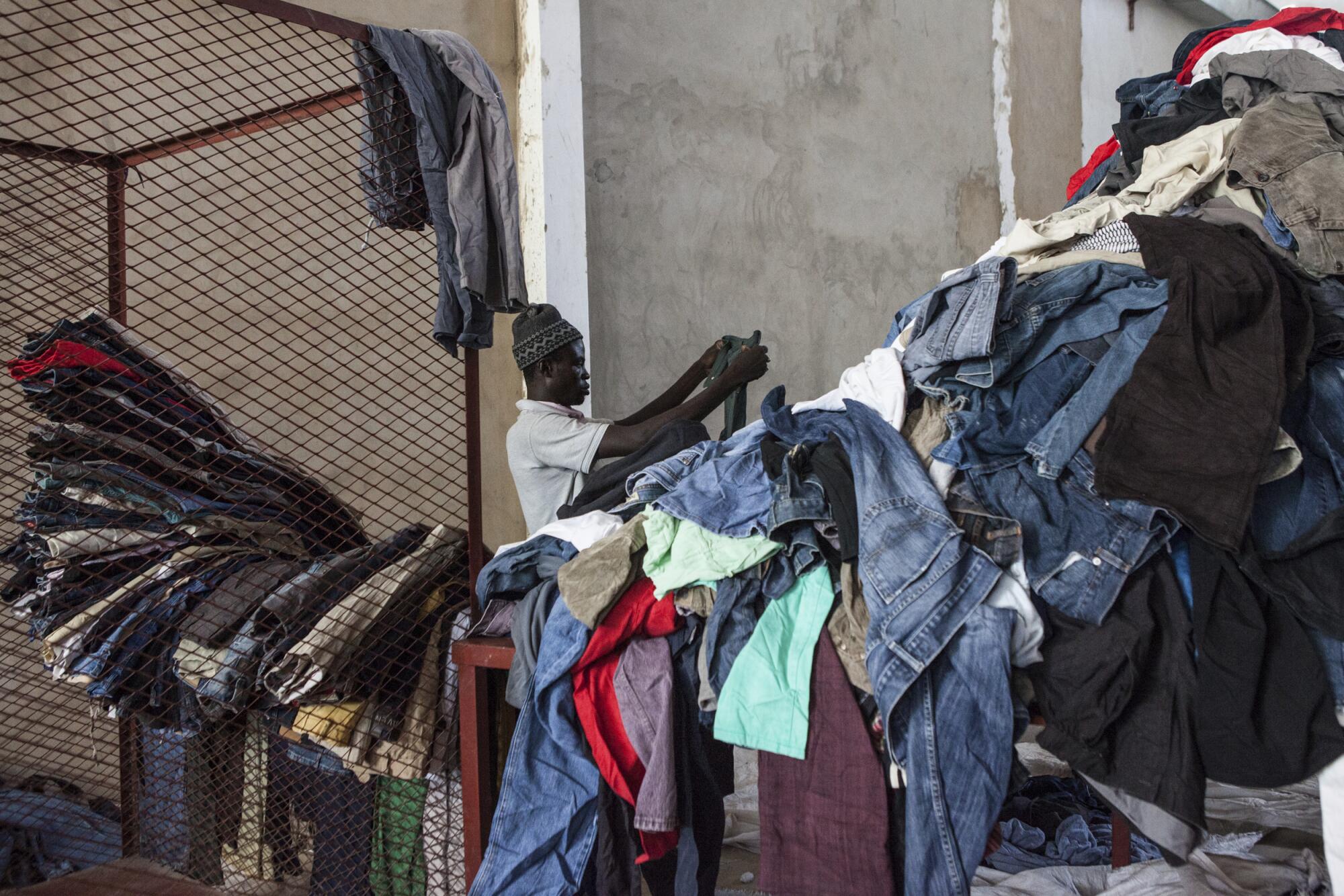
Dame Sall sorts and folds secondhand jeans imported from Italy at a warehouse in Dakar, Senegal. Secondhand T-shirts, jeans and dresses are piled high for blocks along the busy streets in Dakar’s Colobane neighborhood, where people buy them at a fraction of their original price.
(Jane Hahn / Associated Press)
France is leading the effort to push back against fast fashion. In March, the lower house of Parliament approved a bill that would ban advertising for such items and impose penalties per piece of clothing sold. France has proposed a European-Union-wide ban as well on used clothing exports to discourage discarding cheap goods that end up in landfills overseas.
New York lawmakers have crafted a bill that would require major fashion brands doing business in the state to map and disclose supply chains to avoid labor exploitation and environmental harm.
According to McKinsey’s 2024 State of Fashion report, 87% of fashion executives surveyed believe sustainability regulations will affect their business this year. “The game is changing,” Lu said. “These regulations and consumer changing behavior will really place some pressure on these fast-fashion brands.”
Shein, which uses predictive analytics to determine what clothing designs will sell best, has argued that its business model is less wasteful than traditional retailers’ because it produces only as much as customers order.
Still, those companies most associated with the phenomenon are trying to diversify their offerings to eschew the label of fast fashion and all its negative connotations.
With a new third-party marketplace, Shein customers can now find secondhand luxury goods on its site. Zara, the onetime fast-fashion pioneer, has pledged to transition to all sustainable, organic or recycled material by 2025, and incorporate offerings of higher quality and cost to its product lines.
But the influence of fast fashion isn’t going away — exemplified by the global garment supply chain, which has been altered as traditional retailers have adopted practices to increase their own speed and flexibility.
Before the advent of fast fashion, a standard piece of apparel took about two months to produce, according to Raymond Wong, a professor in the department of logistics and maritime studies at Hong Kong Polytechnic University. Now fast fashion can produce an item, from concept to delivery, in less than two weeks.
And as production capabilities have sped up, so have the life cycles of the clothing that retailers are selling. While clothing collections have traditionally been seasonal, fast-fashion brands can launch at least one new collection per month now, Wong said.

Fast-fashion sellers Shein and Temu have proved to be wildly popular in the United States.
(Richard Drew / Associated Press)
And being fast, brands have learned, pays off.
Profit margins at companies that embrace fast fashion are generally higher than traditional retailers, Wong said, because they prioritize sales volume and low-cost production. Keeping sparse inventory also means that they don’t have to offer steep discounts to offload unsold merchandise.
“This is the philosophy of the fast fashion retailer: If you can put your item in the store one day earlier, you have higher possibility and probability to sell more,” Wong said.
A more flexible production cycle means that brands are working with more vendors, manufacturers and suppliers than before. That makes assessing the supply chain for transgressions in labor and environmental standards more challenging.
Sanchita Saxena, a professor at UC Berkeley who studies labor and garment supply chains in Asia, said that while more brands are trying to improve sustainability, their cost expectations make it difficult for suppliers, many of which are taking losses on accepted orders, to take action.
The impact of fast fashion is “terrible for workers because the cycle is so quick and the turnaround time is so fast, there is no way a human being can produce the amount of goods that is required,” Saxena said. “But they’re getting incredible pressure to do that, and they’re always getting pushed on price.”
Despite concerns about the negative impacts of fast fashion and sustainability pledges, experts say consumers alone won’t have much influence in how the clothing supply chain adapts.
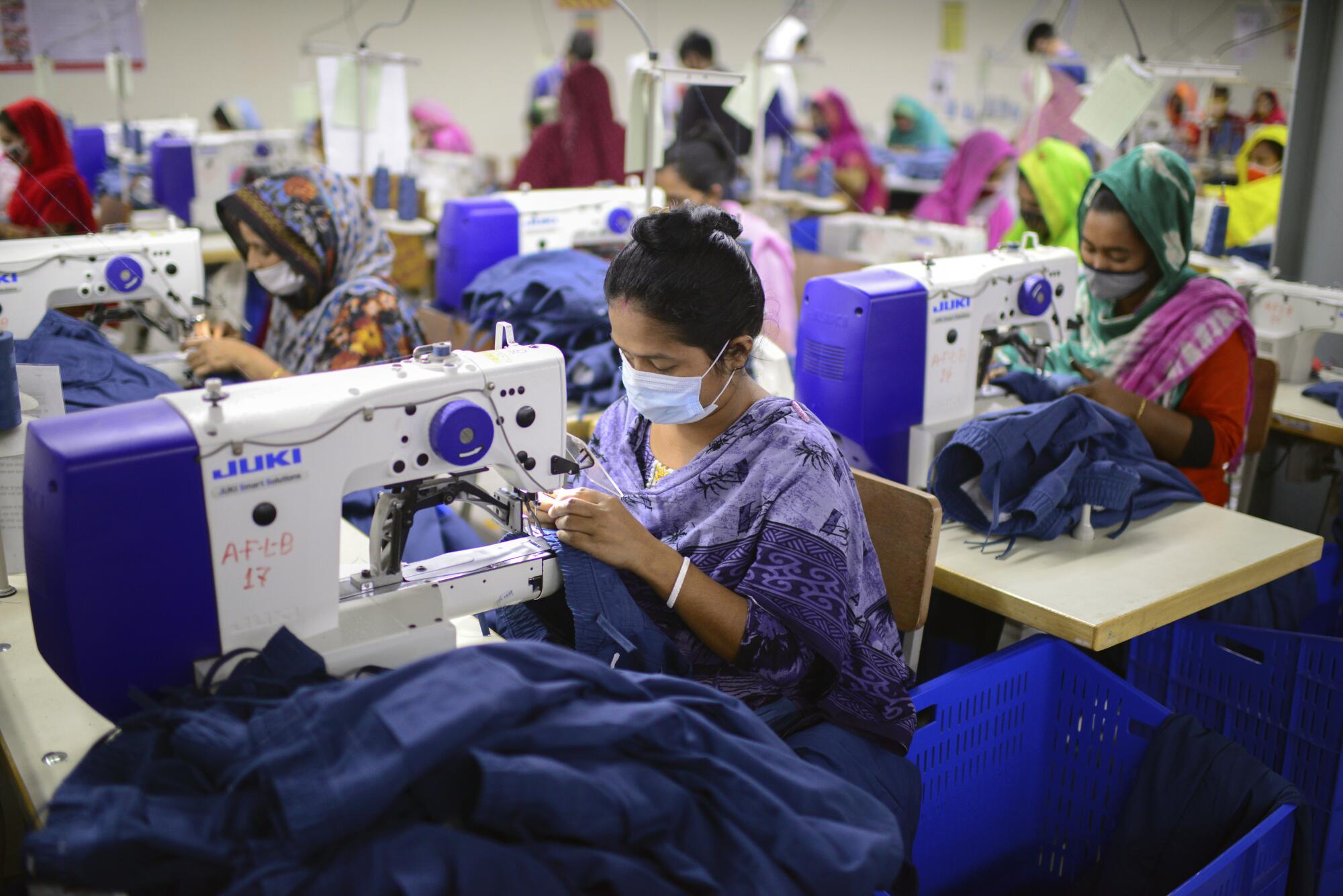
Garment employees work at Arrival Fashion Limited in Bangladesh. Critics of fast fashion have long warned consumers to stop treating clothes like throwaway items.
(Mahmud Hossain Opu / Associated Press)
“The consumer is making statements that they want to purchase more ethically and responsibly, but they’re not really showing that in the scale that is necessary to make brands act,” said Divya Demato, chief executive of San Francisco-based supply chain consulting firm GoodOps.
Temu, a low-cost shopping app that gained popularity last year, was created by the Chinese e-commerce platform Pinduoduo to tap into that price sensitivity among U.S. consumers.
According to McKinsey, 40% of U.S. consumers have shopped at Shein or Temu in the last 12 months. Many survey respondents said they intended to buy more from those fast-fashion brands in the next two to three years.
“It becomes sort of a chicken-or-egg situation. Brands say ‘Consumers want it, so we give it to them,’ and consumers say, ‘Well, brands are doing this, so we are buying it,’” Saxena said. “Which came first? I don’t know — but someone needs to stop that cycle.”
Special correspondent Huiyee Chiew in Taipei, Taiwan, contributed to this report.

Lifestyle
After more than a century, the Campbell's company drops 'soup' from its name

Cans of Campbell’s soup are displayed on a shelf at a grocery store in Richmond, Calif., in 2019. The Campbell Soup Company says it’s changing its corporate name to The Campbell’s Company.
Justin Sullivan/Getty Images
hide caption
toggle caption
Justin Sullivan/Getty Images
After more than a century, The Campbell Soup Company, whose soup cans were famously rendered iconic by Andy Warhol, says it’s dropping “Soup” from its corporate name and adding an apostrophe.
The company, which had net sales of $9.6 billion last year, was founded in 1869 as Anderson & Campbell and adopted its current name in 1922.
The Camden, N.J.,-based food giant said changing its name to The Campbell’s Company is “part of its evolution” as it adopts a “new strategy [and] new mission.”

“This subtle yet important change retains the company’s iconic name recognition, reputation and equity built over 155 years while better reflecting the full breadth of the company’s portfolio,” Campbell’s CEO Mark Clouse told investors this week.
It’s just the latest familiar brand to see a corporate name change: Not long ago Twitter became X and Dunkin’ Donuts became just Dunkin’.
The Campbell’s name change is subject to shareholder approval in November.

In addition to soups, Campbell’s also owns a variety of familiar brands including Pepperidge Farm, Prego and V8.
Big consumer names have been under increased pressure in recent years, especially as inflation drives grocery shoppers to seek out store brands to try to save money.
Lifestyle
What does a busy president want to eat? This White House chef has the answer

President Biden welcomes then White House executive chef Cristeta Comerford to the podium during a reception celebrating Asian American, Native Hawaiian and Pacific Islander Heritage Month in May.
Mandel Ngan/AFP via Getty Images
hide caption
toggle caption
Mandel Ngan/AFP via Getty Images
You know that old line, “Tell me what you eat and I’ll tell you who you are”? If that’s true, then Cristeta Comerford knows the last five presidents of the United States better than almost anyone.
Comerford just retired after nearly 30 years as White House chef. She cooked for presidents from Clinton to Biden, making everything from family snacks to state dinners.
Just days before she left D.C. and moved to Florida, she came to the NPR studios to look back on her career, and said she didn’t think about the barriers that she broke when she became the first woman and the first person of color to hold the top job in the White House kitchen.

“I didn’t even realize that, because I was just doing what I wanted to do. I love to cook. It just so happens that I’m a minority woman,” she said. “But when I broke the glass ceiling, I didn’t realize that it was, like, news all over!”
That was in 2005 during the George W. Bush administration that she took the executive chef position.
Comerford sat down with All Things Considered host Ari Shapiro to talk about how she prepares to cook for the most powerful person in the world, how the food she sometimes chose connects to her youth, and what President Obama once said about her hamburgers.
This interview has been lightly edited for length and clarity.
Interview highlights
Ari Shapiro: You were born in the Philippines. You grew up one of 11 children in Manilla and you came to the U.S. at the age of 23. Did any of the presidents you worked for ask you to cook the food of your childhood, the food you grew up with?
Cristeta Comerford: President Obama, he lived in Hawaii for a while, so there’s a lot of Filipino communities there, so he’s very familiar with the Filipino food. So every now and then I’m, like, on the grill, and he’s like, “Hey, is that smelling good right there.”
Shapiro: Give us an example.
Comerford: The skewered pork, you know, that’s like a street food, but that’s something that I love very much. And then whenever I did that — I do beef as well, and chicken — he loves it.

Comerford at the White House in 2012.
Susan Walsh/AP
hide caption
toggle caption
Susan Walsh/AP
Shapiro: That must have been so nice to share the food of your roots, of your childhood, in your job at the White House with the president
Comerford: Exactly, yes.
Shapiro: I think the last time the White House hosted a state dinner for the Philippines, if I’m not mistaken, was 2003 during the George W. Bush administration. What was that day like for you?
Comerford: It was amazing. Because actually, chef Walter Scheib — the executive chef then — asked me to write the menu. I actually did the press preview for [Philippine President Gloria] Macapagal-Arroyo at the time. So I was so excited. They chose lamb. I clearly remember, because it was, like, kind of unusual, like, “Lamb? For Filipinos?” But I’m like, “OK, if that’s what the guests want, we’re gonna do lamb.”

First Lady Laura Bush with Comerford next to samples of the food that will be served during holiday parties in the State Dining Room in 2007.
Saul Loeb/AFP via Getty Images
hide caption
toggle caption
Saul Loeb/AFP via Getty Images
Shapiro: What did cooking for presidents show you about those leaders that even their chiefs of staff or their closest advisors might not have understood?
Comerford: I think at the end of the day, those presidents, they have the weight of the world on their shoulders. So the only thing that they want when they come home after working the Oval Office, dealing with whatever world or domestic events, is just to come home to a nice, home cooked meal.
So on a daily basis, we just really take care of them: “Hey, what do you like to eat?” And a part of being a chef is just reading the room, but reading a big room, because you have to watch the news. You have to keep up with what’s happening, because you almost kind of know what mood is your principal going to be in.

Shapiro: Oh interesting. You’re watching the news to see if it was a stressful day for the person you’re cooking for. So it’s like, “Oh, he’s gonna need grilled cheese and tomato soup” and the end of this day?
Comerford: Yeah exactly. And people don’t teach us that. We just kind of know. I learned it from, actually, one of our butlers, because he was the one who explained to me, “Cris, he’s gonna be feeling tired today and just worn out. So give him what you got.”
Shapiro: If I were to ask all five presidents what dish Cris is best known for, do you think more than one of them would give me the same answer?
Comerford: I think two of them would give you the same answer. Because President Clinton’s favorite is enchiladas. And of course, so is President Bush’s. So they’ll give the same answer. I make a mean enchilada — homemade tortillas. It has to be homemade.

First Lady Michelle Obama greets Comerford as she talks to visiting culinary students in 2009.
Pool/Getty Images
hide caption
toggle caption
Pool/Getty Images
Shapiro: Did a president ever say to you, “Cris, you’re an extraordinary cook. But you know what? I don’t want the handmade tortilla. I want the American cheese wrapped in plastic that I grew up eating”?
Comerford: Actually, it was President Obama. I was making this fancy cheeseburger for him. I made my own brioche dough, and he looked at it and he said, like, “I’m OK with just the grocery bun that you get.”
Shapiro: One of your former colleagues, the pastry chef Bill Yosses, told me that your philosophy of American cuisine is that it’s like jazz. What does that mean?
Comerford: It was a New York Times reporter who asked me the question of like, “Do you think French food is the best?” And we were in France. But what I said was true. I’m like, “Hey, look, all of the chefs, we’re all classically trained. Like, you know, a pianist is classically trained in music. But in America, we play jazz.”
Shapiro: And what does that mean in terms of food?
Comerford: In terms of food, it’s like, every community, every minority groups — we’re a land of immigrants, so we share everything that we have. So by the time a food is made, it’s a totally different one than it was intended to be. It’s because it’s a beautiful melting pot.
Shapiro: It’s less about authenticity and more about improvisation, is that it?
Comerford: Exactly, yes.
Shapiro: Last I checked, the new White House chef, your successor, had not yet been announced. Do you have any words of advice for your successor?
Comerford: I think I’m gonna give him the same word of advice that Walter Scheib gives to every chef: Basically, you leave your politics at the door. Because at the end of the day, we’re cooks, we’re chefs. We just want to make them happy with our food.
Lifestyle
Taylor Swift Thanks Travis Kelce During VMA Awards Acceptance Speech
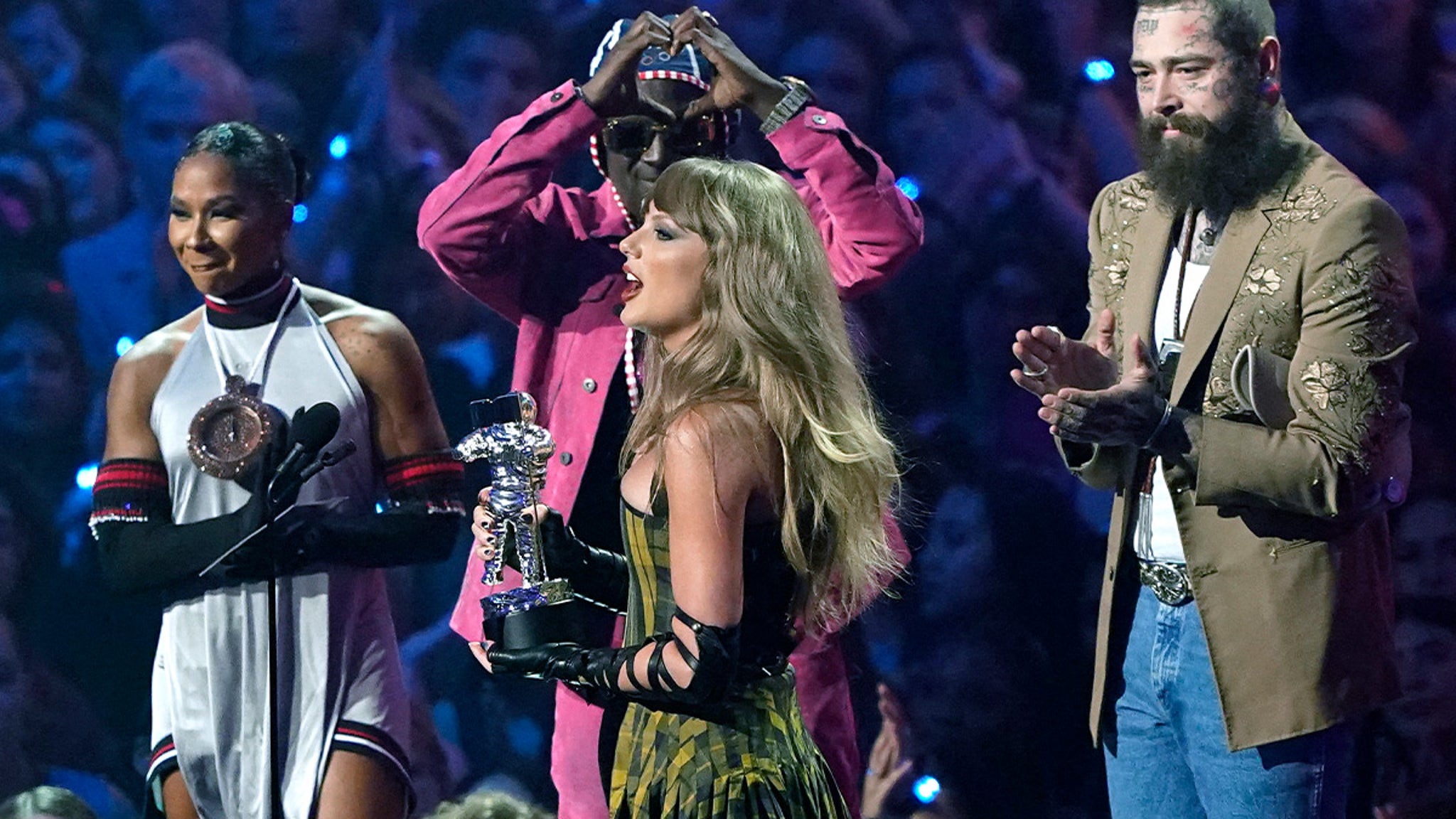
Taylor Swift took home a big win at the MTV Video Music Awards Wednesday night – but the biggest winner was her BF Travis Kelce who wasn’t even in the room!
The pop megastar snagged the VMA for Video of the Year for her tune, Fortnight, and was handed her trophy by none other than the show’s host Megan Thee Stallion.
“My boyfriend, Travis. Everything this man touches turns to happiness, fun and magic, so I want to thank him for adding that to our shoot.” — Taylor Swift pic.twitter.com/jFv0rBGiha
— Taylor Swift Charts (@chartstswift) September 12, 2024
@chartstswift
Taylor stepped up to the mic onstage to give a speech thanking the people who helped her create the music video.
She first acknowledged Post Malone, Ethan Hawke and Josh Charles, as well as cinematographer Rodrigo Prieto and production designer Ethan Tobman.
Then Taylor got to the most important person in her life, Travis, telling the audience a story about him on the set of the video shoot.
She recalled finishing each take of the video and hearing someone cheering in the studio — and that individual was her lover boy — Mr. Kelce.
Taylor said, “Everything this man touches turns to happiness and fun and magic, so I want to thank him for adding that to our shoot.”
The crowd went wild with applause. Unfortunately, Travis couldn’t make the awards show because he was busy practicing with his Kansas City Chiefs teammates for their upcoming game against the Cincinnati Bengals.
-

 Business1 week ago
Business1 week agoHow Self-Driving Cars Get Help From Humans Hundreds of Miles Away
-
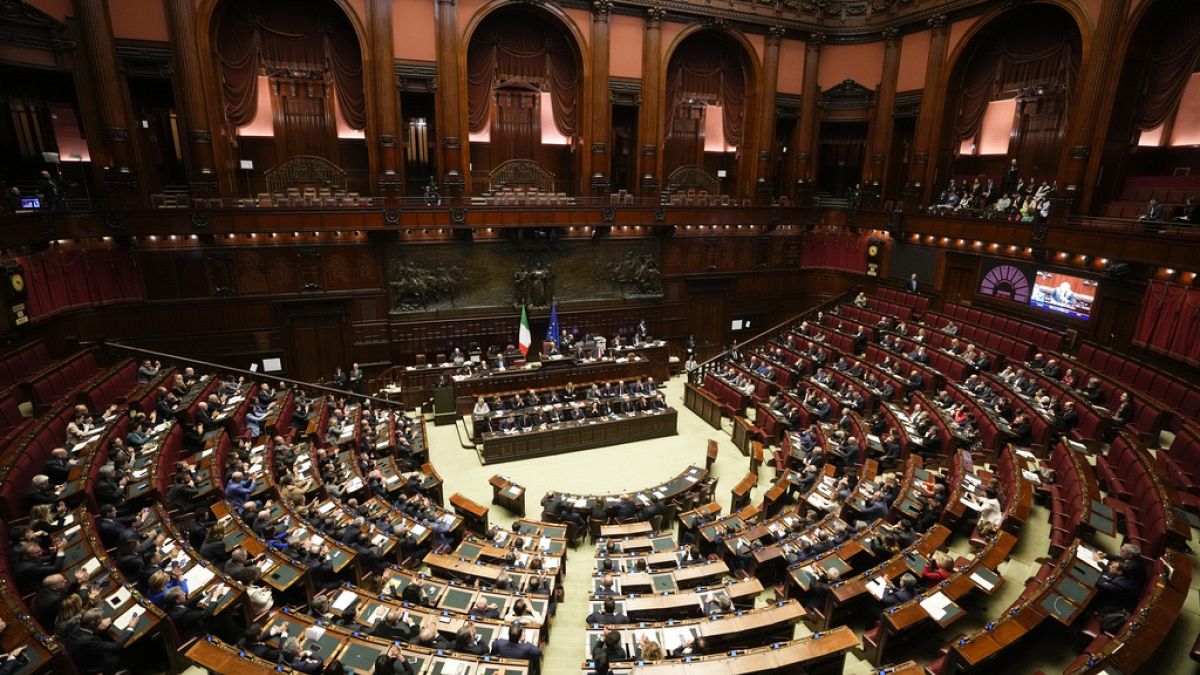
 World1 week ago
World1 week agoMeloni says 'we are making history' as Italy’s FDI reviews progress
-

 World1 week ago
World1 week agoIsraeli forces using ‘war-like’ tactics in occupied West Bank: OCHA
-

 Movie Reviews1 week ago
Movie Reviews1 week agoQueer: Daniel Craig shines in Luca Guadagnino’s steamy drama
-

 World1 week ago
World1 week agoHow Venezuela’s recent history can inform its present-day election crisis
-

 News1 week ago
News1 week agoGeorgia school shooting live updates: Casualties reported at Apalachee High School, suspect in custody
-

 World1 week ago
World1 week agoFrontex chief: NGO rescue ships don't embolden Mediterranean migration
-
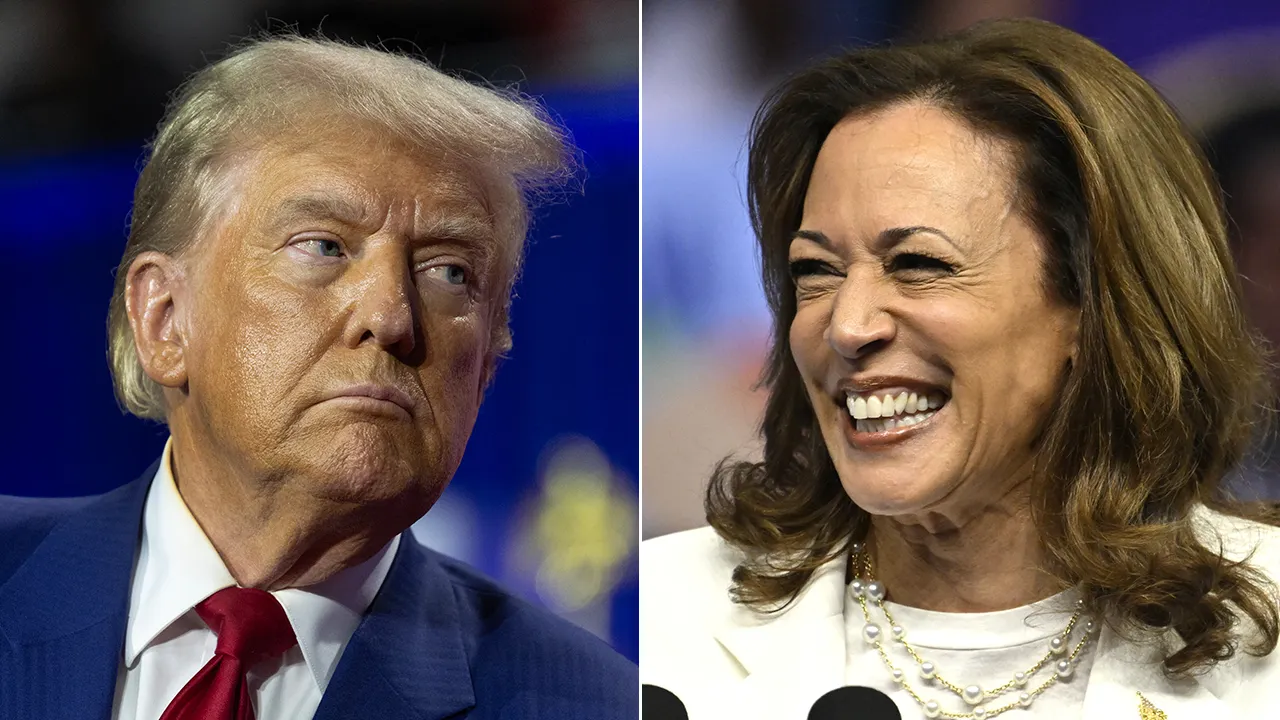
 Politics1 week ago
Politics1 week agoTrump, Kamala aiming for the middle with varying degrees of success
